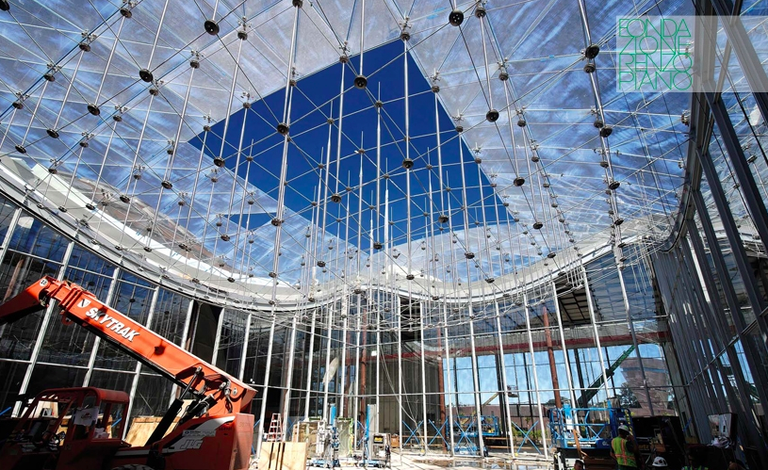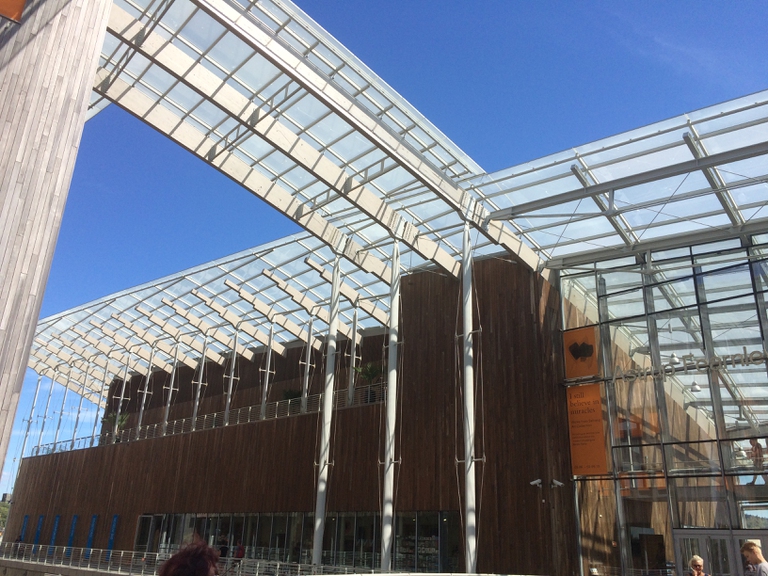
The 50th anniversary of the Moon landing on 20 July has awakened the fantasy of many. Here’s the perfect playlist of musicians who have let themselves be inspired by the universe and its celestial bodies.
Renzo Piano’s archive in Genoa houses the great architect’s projects. It brings young people closer to creative work, which he equates to “looking into darkness without fear”.
Archives have recently become the object of a historical and scientific debate involving more than just experts and professionals. Not only are they spaces devoted to the memory and conservation of materials from the past, they’re also vehicles for experimentation, research, relationships and organising content, as well as maps and cultural systems. Knowing what has come before us is essential in designing the present and future. The story of the archive dedicated to the projects of architect Renzo Piano in his home city of Genoa, in Italy, is the subject of the documentary The Power of the Archive: Renzo Piano Building Workshop by Francesca Molteni and Fulvio Irace, the first in a series tackling great contemporary architects.
[vimeo url=”https://vimeo.com/293319770″]Video Cano Cristales[/vimeo]
There’s a moment in which we realise that the memory of things has left a mark. Like when you have to clear out your house because you realise you’ve accumulated too much stuff. It can’t be helped. The time comes when it has to be done.Renzo Piano
For centuries, archives – from the Greek word for “government”, archeion – were considered the physical emblems of the power of the law. Today, after decades of interaction with digital media, the focus tends to be on the power of the archive as an extension of the property of time, beyond the past and present. Archives must “bite the future“, French historian Jacques Le Goff stated twenty years ago, questioning their traditional status as a repository of old memories, and empowering them instead to challenge what lies ahead. The discussion opens up possibilities for archives to become more open, to be visited, explored and understood by activating multiple approaches that reveal new processes of contemporary thought.
An archive tied to a professional practice such as an architecture studio contains heterogeneous materials – sketches, mock-ups, models, renders, designs, maps, photographs and even audiovisual media. The Renzo Piano Building Workshop (RPBW) archive, dedicated to the great architect’s studio, is housed in a 3,000 square metre converted warehouse in Genoa and reflects the architect’s identity, thought and design methods.
“Why build an archive? – Renzo Piano asks himself –. You do it because it’s of interest to others, to young people. Young people need to understand that ideas don’t come about in a really complicated way. Being an architect means sharing creativity. If it isn’t shared, you can’t survive, there’s no other way around it”.
Another recent film, Renzo Piano: The Architect of Light by Spanish director Carlos Saura, a good friend of Piano’s, tells the story of the project for the Botin Foundation in Santander, Spain. “Do you want to know the secret? All it takes to have ideas is to decide to have them,” Piano tells Saura. “There’s a common red thread that connects technique – indeed, téchne (from the Greek τέχνη, “craftsmanship”, as in expertise and skill), which is a more subtle concept – and poetry… Creativity is a bit like looking into darkness without fear. It’s hard to even speak of beauty, the idea of beauty is fleeting. This type of beauty can save the world. It might be utopian, but what else can we do?”.
The idea of creating an orderly and organised archive first came to the architect around the year 2000, while two exhibitions of his work were taking place in Berlin and Paris. The aim was to create a space dedicated to memory in which to share the story of many projects, and make them accessible to all. During a journey to Japan, while observing the construction of a Shinto temple, Piano began to ask himself how he might pass his professional experience onto young people.
In Shinto tradition, every twenty years the temple is demolished and an identical one is built on a plot of land next to its predecessor. The goal is to pass on building techniques and artisanal expertise from one generation to the next. Three generations meet during construction: those aged sixty and above who are the teachers; those who, having already learned, execute the construction perfectly; and finally, the youngest watch and learn. Observing these practices is what led to the idea of creating an archive through a foundation, and welcoming students in the style of Renaissance “bottegas” or workshops.
In 2004, this led to the creation of the Renzo Piano Foundation at Villa Nave, in Genoa. This non-profit institution is devoted to promoting the architectural profession, and championing study and research. Its programme is built around several activities: conservation and enhancement of the archive, training and outreach.
The documentary centred on Renzo Piano and the archive, created in collaboration with the foundation and RPBW, premiered last October at the Milano Design Film Festival 2018. “The RPBW archive is a metaphor of a seaport – the filmmaker, Molteni, recounts – in which materials come and go, and every time they return they bring back something new, perhaps something unexpected, which enriches its content and communicative potential. Every archive is the most faithful portrait of its author’s biography: an ordered labyrinth of documents that envelop this figure, who is laid bare by the words on these pieces of paper, previously unknown to the public. We made the film with this belief, and the desire to unmask a less well-known side of the processes and practices performed by an architect and his studio”.
In addition to the logic of sorting and organising, therefore, these archives are also based on creating new inquiries, building new pathways, feeding curiosity, doubts and uncertainties, generating interpretations and bringing history to the attention of future generations. Entrance to Piano’s archives is free and limited to students and researchers, though open to the public the first and third Saturday of every month.
Siamo anche su WhatsApp. Segui il canale ufficiale LifeGate per restare aggiornata, aggiornato sulle ultime notizie e sulle nostre attività.
![]()
Quest'opera è distribuita con Licenza Creative Commons Attribuzione - Non commerciale - Non opere derivate 4.0 Internazionale.
The 50th anniversary of the Moon landing on 20 July has awakened the fantasy of many. Here’s the perfect playlist of musicians who have let themselves be inspired by the universe and its celestial bodies.
N’we Jinan is a Canadian record label that gives First Nations students their voice back by allowing them to create their own music in mobile recording studios.
The Australian songwriter, who became famous with Follow the Sun, is back with Walk Away, a new and powerful ode to freedom. He’s about to set off on a world tour. Our interview with Xavier Rudd.
Three teenagers from New Zealand sing in the Maori language about abuse at the hands of British colonisers. Thanks to their thrash metal music, young people are being attracted to native culture.
There’s no room for anger, resignation, or desire for revenge in this playlist. There’s just the moral obligation of retracing and telling the stories that can’t go lost and forgotten all over again. We do so through music.
Le canzoni più belle del 2017 secondo LifeGate Radio. Con questa playlist lanciamo la nostra collaborazione con Spotify Italia che vi farà ascoltare la musica migliore, selezionata.
An organisation that unites over 1,000 mainly Maya women in Guatemala has expressed alarm that indigenous handicrafts, textiles called “huipiles” in particular, are under threat because underpriced industrial fabrics appropriating indigenous patterns have flooded the Guatemalan market, depriving many native women of their main source of income. Read more: Down to Xjabelle, the fashion collection by a young designer with Down
Rwandan creatives share a common dream: they want to use their art to bring about positive change in society, as well as put their country on the map. They’re mostly young, ambitious, self-taught and have a strong desire and determination to challenge mentalities, move forward and grow. In her documentary RWANDArt: A new creative generation, which
Korogocho, Kenya, is Nairobi’s third slum. It rises on the huge mountain of trash of Dandora landfill (the capital’s biggest dumpsite) and about 200,000 people live there in tin sheds built on an area of approximately one and a half square kilometers. Unlike Muthaiga, one of Nairobi’s wealthiest areas located less than two kilometres away from










